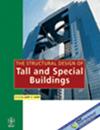新型钢板焊接工字钢与箱形柱连接方式的研究
IF 1.3
3区 工程技术
Q3 CONSTRUCTION & BUILDING TECHNOLOGY
引用次数: 0
摘要
箱钢柱与H柱相比具有明显的优势。然而,箱钢柱由于应力集中,在柱板区有塑性铰的不利趋势。移动柱面板区域应力集中的方法之一是采用减梁。然而,减小的梁会降低梁的容量。本文提出了一种不降低梁承载力的塑性铰位置的解决方案。在本研究中,使用ABAQUS软件对106种连接配置进行了数值研究。两个相关的实验研究被用来验证建模技术。根据欧洲规范‐3,建议的连接被分类为半刚性和全强度。为了预测所提出的连接的循环行为,使用使用Richard和Abbot函数的Matlab程序进行了分析模拟。该程序能够准确地再现连接行为。通过参数化研究,考察了板厚、柱和梁几何形状对连接初始刚度和弯矩抗力的影响。最后,通过回归分析,提出了能够预测连接初始刚度和弯矩阻力的线性函数。本文章由计算机程序翻译,如有差异,请以英文原文为准。
Development of a novel I‐beam to box column connection with welded steel plates
Box steel columns have significant advantages compared with H‐columns. However, box steel columns have the detrimental tendency of developing a plastic hinge at the column panel zone due to stress concentration. One of the methods for moving the concentration of the stresses at the column panel zone is to use a reduced beam. Nevertheless, a reduced beam decreases the capacity of the beam. This paper proposes a solution to the plastic hinge location without reducing the capacity of the beam. In this study, 106 connection configurations were numerically investigated using ABAQUS software. Two relevant experimental studies were used to validate the modeling techniques. The proposed joint was classified as semi‐rigid and full strength according to Eurocode‐3. To predict the cyclic behavior of the proposed connection, analytical simulation was performed using a Matlab program that uses the Richard and Abbot function. The program was able to accurately reproduce the connection behavior. Through parametric studies, the influence of plate thickness, column, and beam geometry on the connection's initial stiffness and moment resistance was examined. Finally, by using regression analysis, linear functions capable of predicting the initial stiffness and moment resistance of the connection were proposed.
求助全文
通过发布文献求助,成功后即可免费获取论文全文。
去求助
来源期刊
CiteScore
5.30
自引率
4.20%
发文量
83
审稿时长
6-12 weeks
期刊介绍:
The Structural Design of Tall and Special Buildings provides structural engineers and contractors with a detailed written presentation of innovative structural engineering and construction practices for tall and special buildings. It also presents applied research on new materials or analysis methods that can directly benefit structural engineers involved in the design of tall and special buildings. The editor''s policy is to maintain a reasonable balance between papers from design engineers and from research workers so that the Journal will be useful to both groups. The problems in this field and their solutions are international in character and require a knowledge of several traditional disciplines and the Journal will reflect this.
The main subject of the Journal is the structural design and construction of tall and special buildings. The basic definition of a tall building, in the context of the Journal audience, is a structure that is equal to or greater than 50 meters (165 feet) in height, or 14 stories or greater. A special building is one with unique architectural or structural characteristics.
However, manuscripts dealing with chimneys, water towers, silos, cooling towers, and pools will generally not be considered for review. The journal will present papers on new innovative structural systems, materials and methods of analysis.

 求助内容:
求助内容: 应助结果提醒方式:
应助结果提醒方式:


